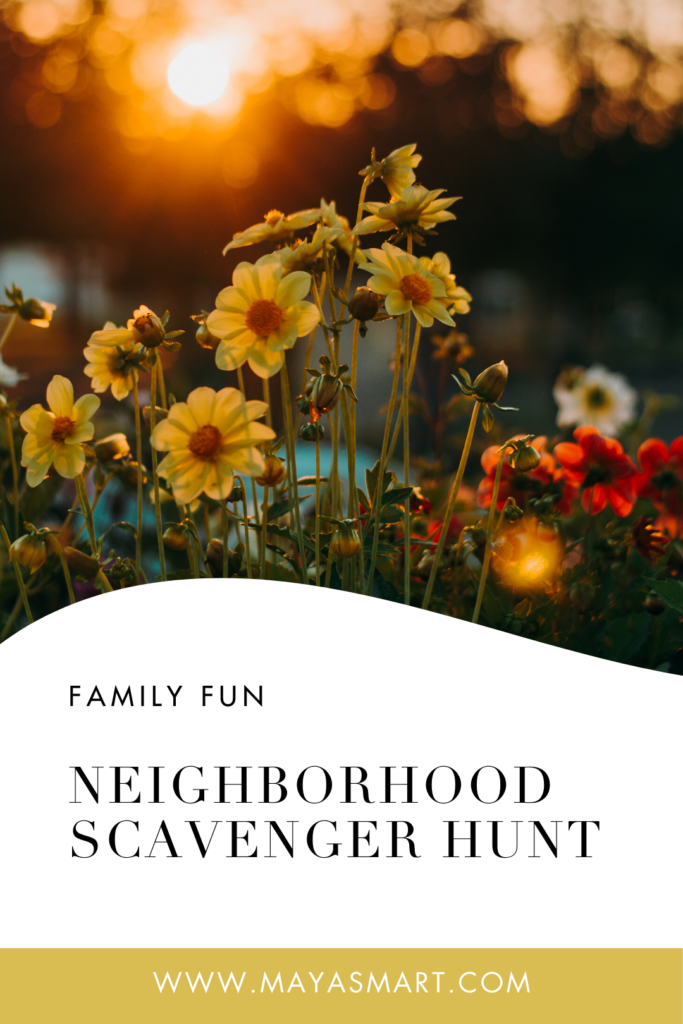By nature, children are learners and discoverers. But there are some crucial skills—like letter shapes, names, and sounds—that parents should teach rather than wait for kids to sort out on their own. And the more fun and light-hearted the approach, the better.
Try this neighborhood scavenger hunt activity to engage kids and have family fun outdoors. Getting outside, moving around, and boosting letter engagement is a win-win-win. Benefits include:
- Affordability. You don’t need to purchase a thing for this activity. The items on your hunt list can all be found outside, and you can keep track of items with pen and paper.
- Simplicity. You can read hunt item names aloud for younger children or have more advanced readers scan the list themselves. Easy!
- Health. The neighborhood scavenger hunt is completed outdoors, so it gives you and your child exercise and fresh air.
- Presence. Strolling the neighborhood at a leisurely pace provides a welcome break from technology and a chance to notice surroundings.
- Togetherness. This time spent with your child will strengthen your bond and may lead to future nature walks and educational outings.
Plus, the activity is adaptable enough to try with a wide range of ages. The neighborhood scavenger hunt helps preschoolers and elementary school children increase their letter knowledge. But by incorporating camera phones and social media, your middle schoolers and even high schoolers can get engaged in the hunt as well. They could take pictures of their finds from A to Z and share and compare the results with their friends.
Materials:
- List of hunt items
- Pen
- Notebook or paper (optional)
- Camera (optional)
Steps for Your Neighborhood Letter Scavenger Hunt
- Decide which letters to find. Depending on your child’s age, attention span, and personality, you may opt to use the entire 26 letters of the alphabet, or focus on a subset of letters, such as those in the child’s name. The key is to provide the right level of challenge for your child.
- Set search parameters. After you decide on the letters, figure out how you want your child to look for them. Some examples include:
- Finding items that begin with each letter (A for acorn)
- Finding the letters themselves (S in a stop sign)
- Finding objects that make the shape of a letter (X pattern in a backyard fence)
- Set a time limit. I recommend about 30 minutes for the outdoor scavenger hunt, but you can use more or less time if needed.
- Start hunting. Explain to your child that you’re about to begin an alphabet-inspired adventure and get going!
Alphabet-Inspired Scavenger Hunt Items
Use the suggested items below as inspiration for your list. Be creative and see what alternative scavenger hunt items you and your child can find for each letter. Make adjustments on the fly as you explore your neighborhood on foot.
- Acorn
- Bike
- Cat
- Dog
- Earrings
- Fire hydrant
- Grass
- Hoop
- Insect
- Jump rope
- Kite
- Leaf
- Mailbox
- Neighbor
- Orange
- Pet
- Question
- Rock
- Sign
- Trash can
- Umbrella
- Vehicle
- Water hose
- X shape
- Yard
- Zipper
Four Ways to Customize Your Alphabet Scavenger Hunt
The beauty of neighborhood scavenger hunts is that there are a lot of ways to change this simple activity to keep it engaging for you and your children over time. Here are just a few tips:
- Take turns with your child to find letters. This is especially helpful if your child is having trouble with certain letters and sounds.
- Work with your child to plan a route for the scavenger hunt. If there’s a particular place they love to visit, you can add that stop as part of your plan.
- Create your own list by jotting down items as you find them.
- See how many times you can find a certain letter or letter sound while on the outdoor scavenger hunt. For example, how many items start with the letter S on your hunt?
Three Scavenger Hunt Books for Children
Introduce or extend the activity with some scavenger hunt reading inspiration. Here are a few titles to consider.
The Lunchnapper by Rick DeDonato (Ages: 3-7)
Pipsie and her turtle friend, Alfred, are on the best school trip ever—a nature scavenger hunt! The search deepens when they discover their lunches have gone missing!
Go Find It! An Outdoor Active Scavenger Hunt by Anastasia Kierst (Ages: 5-8)
Outdoor exercise and exploration are essential for young children. Head to your nearest park, playground, or even your own backyard and don’t forget to pack your sense of adventure.
Sunny Day Scavenger Hunt by Meredith Rusu (Ages: 8-12 years)
The WellieWishers are going on a very special scavenger hunt—a colorific one! Each friend chooses a color and whoever finds the most things around the garden in their color wins. This storybook is based on the bestselling American Girl characters.
Try this easy literacy-focused scavenger hunt with your children and let us know how it works for you. How did your kids enjoy finding various alphabet-oriented objects around your neighborhood?



